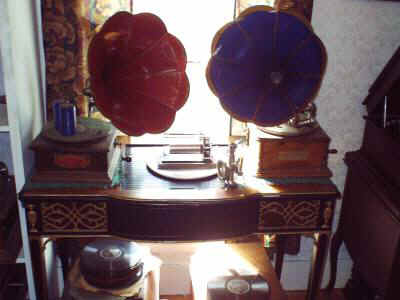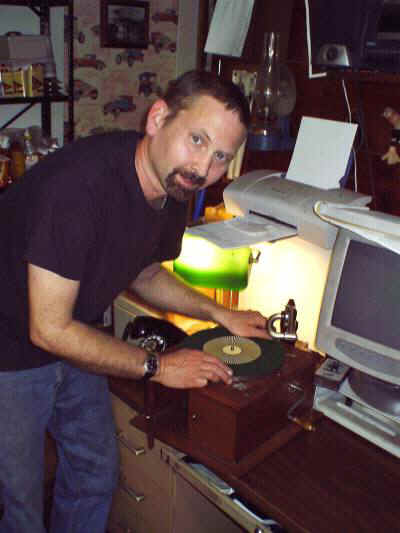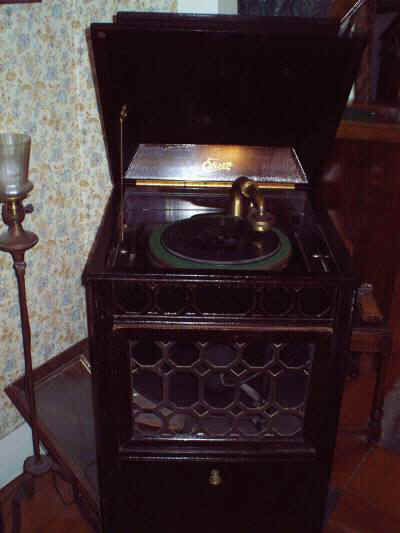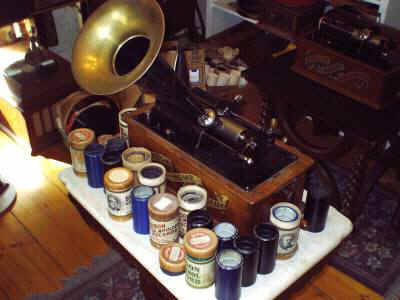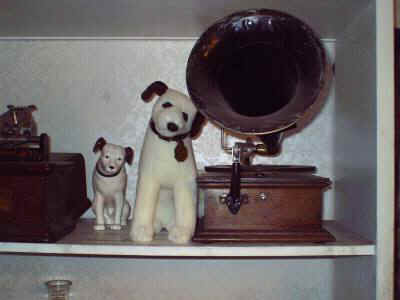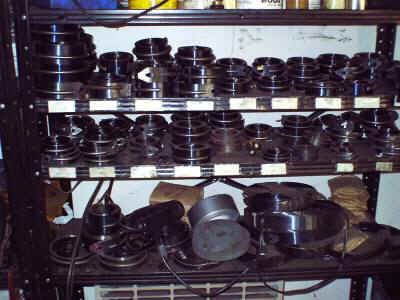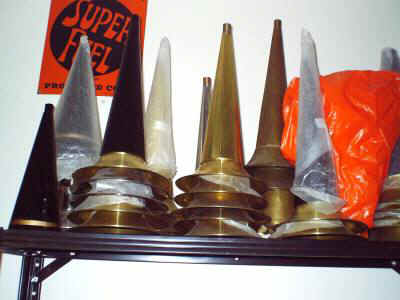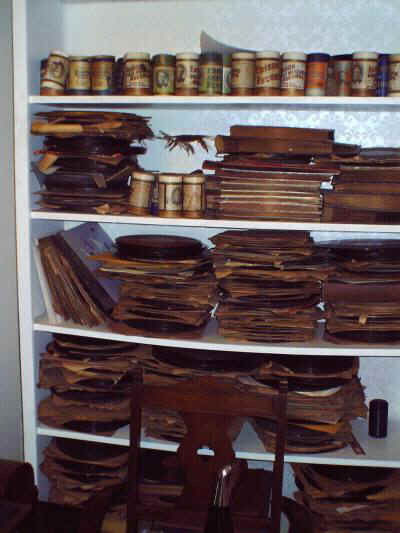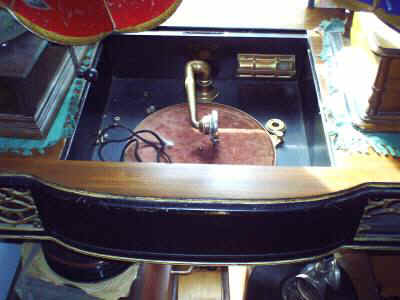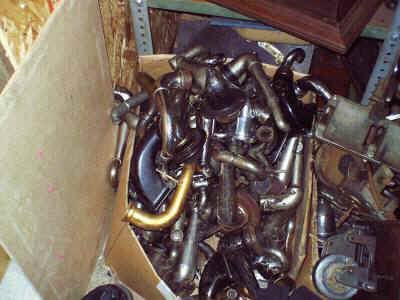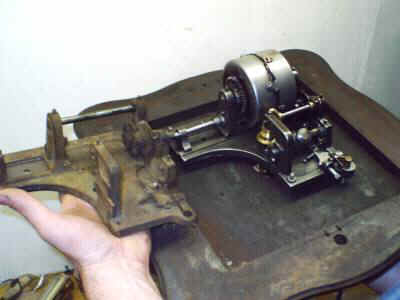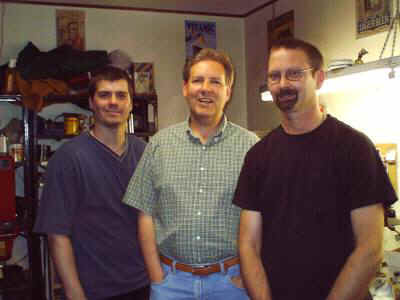|
You are reading the older HTML site Positive Feedback ISSUE 8 august/september 2003
Deep Analog: A Visit to Victrola Repair Service
My dad bought me my first stereo when I was starting ninth grade. Out of the blue, he walked in one night with a gorgeous little Panasonic amp/tuner with two little faux-wood speakers. I still remember setting up the speakers on each side of my waterbed, and hearing stereo in my head for the first time! Along with the amp/tuner came a small Garrard turntable that was, of course, able to run at three speeds, including 78 rpm, so, along with the first albums of Country Joe & the Fish, Traffic, and the Grateful Dead, I was able to play for my friends the 78s that my dad had always kept around in old folios. That music was very different from what we heard growing up in Berkeley in the 60s—names like Billie Holiday, Teddy Wilson, and Jonnie Ray singing "Whiskey and Gin." I still have the Columbia album, Hot Jazz Classics, of red-label reissues of the great early Holiday recordings. All of this went into my permanent musical gumbo. Later, when I visited from college, I listened to those 78 rpm records on the
fine old Sonora floor-standing player that had come to my dad from Great Aunt Shane in
Fresno, along with a bunch of classical recordings in big 12-inch folios that weighed a
ton. That player still works fine today, and when I visit my parents I still spin a 78 or
two like "My Old Kentucky Home" on a large, one-sided 12-inch, or the very
un-P.C. recordings by Two Black Crows that my dad couldn't bear to part with. They usually go for a buck a pop, or less if you buy a bunch, and the shop owners usually don't know or care what is on those records. Billie Holiday 78s are relatively easy to find, since by the end of her life some forty different labels had issued her work! And then there is the deep and endless bounty of great American music that is too obscure to EVER be reissued on CD or SACD or whatever they come up with in the future. For people who really enjoy the vanished highways and byways of American music, this is where the real deal can still be found. I've come across fantastic early bluegrass and country that I'd never heard of. Rarer to find are the early "race" records—i.e. blues—because those are much sought after by the collectors, though they do come up. There is a lot of early R&B and pop out there, right on up through the 50s. A while ago, I bought a Mercury 78 of Patsy Cline's "Walking After Midnight," and that was issued in the early 60s! With an appreciation for the ultimate in analog music reproduction instilled in me by early family experiences, it seemed odd that I didn't own a vintage player until a couple of years ago. I started to look into it on the web, and my search eventually led me to Victrola Repair Service, located in St. Johnsbury, Vermont. I purchased a Victor Model V-IV originally manufactured in 1917, and beautifully restored at their shop. It sits on a table across the living room from all my other hi-fi gear, and when I want to turn back the hands of time, I reach out and crank it up.
I have no doubt that for some readers, there is something magical and time-altering about the totally analog music reproduction process of playing a vintage 78 on a vintage wind-up phonograph. When you play Billie Holiday this way, she really IS right there, right now! Prior to the electrification of the recording process, what you hear in early recordings is the result of an entirely mechanical, acoustic process of recording and playback. There are many histories concerned with the early years of the recording industry, but I found a useful starting point to be Hand Cranked Phonographs by Neil Maken. You can find this brief book for sale, along with other texts and supplies, on the Victrola Repair Service website at www.together.net/~victrola. Be sure to browse their selection of restored players in different categories, from cylinder machines to external horn machines to standing floor models. Rod Lauman founded Victrola Repair Service. With his partner Les Royer, Rod runs one of the few full-time businesses in this country devoted to the repair and servicing of vintage sound reproducers (I would say "record players," except that Victrola Repair Service also supports and sells the earlier cylinder players, such as those made for many years by the Edison Company.) Victrola Repair Service currently occupies a number of rooms in a rambling Victorian house in the village of St. Johnsbury, in northern Vermont. Having spoken via phone and e-mail for several years with Rod and Les, I invited myself for a visit on behalf of Positive Feedback Online earlier this summer. Here is an edited transcript of our conversation, along with some photographs they were kind enough to allow me to shoot. Sasha Matson: How did you get into repairing Victrolas for a living? Rod Lauman: When I was a kid, my grandparents had an Edison Diamond Disc unit in their front hallway. It didn't work for a lot of years. I became interested in it, and worked on it and tried to figure it out. I have that machine in my living room now. I inherited it when my grandparents passed away and my parents brought it back for me in the back of their station wagon. I was in high school, so it was a very early interest.
SM: Did you first start tinkering with them yourself? RL: Yes. I thought at first that all players were Edisons. Then I learned there were all these other kinds, and I started to network with repair people who had been in business for many years. At that point, there were several still in business in California who have since passed away. SM: How many companies are there that restore vintage phonographs? RL: There are three that do it full time and that are busy. There may be others, but I'm not sure. SM: How many people do you estimate listen to vintage 78 rpm recordings today? RL: There are tens of thousands. There are two ends to the hobby. There is the audio end, people who collect 78s. Most of these do not own a wind-up phonograph—they play discs on a hi-fi 78 player. That is probably the majority of people who enjoy the music. And then there's the other end of it, the people who own the players. Sometimes they cross over. My interest is in the mechanical end. SM: When did the 78 rpm standard get established? RL: It was Emile Berliner, in the late 1890s. The Berliner Company became Victor. They needed the speed (78 revolutions per minute) to get acceptable fidelity. Then, when microphones came in, around 1925, they started working with other formats, and then of course they came up with 33s and 45s. SM: So the actual disc rotating at 78 rpm is creating the physical energy for the reproducer? RL: That's right, it allows enough energy for the sound to be reproduced. It wouldn't work at 16 rpm. (At this point, Rod's partner Les Royer joined the conversation.) Les Royer: The reproducer is heavy, and a motor couldn't go that slow and keep a constant speed. Too slow and it would literally grind to a stop, so it had to go at least maybe 60 rpm. I'm sure they worked with it, and the technicians came up with what worked best for acoustic recording. That format (78 rpm) lasted over seventy years. You could still get kid's records on 78 in the 60s. They became plastic at that point—you couldn't break them! SM: How about cylinder recordings versus disc records? RL: Well, the early cylinders were made of beeswax—untreated, brown beeswax. By 1901 or 1902, the molded black wax cylinders were made, and they were two-minute recordings. Then they went to four-minute cylinders in 1904, and over time these supplanted the two-minute recordings. By around 1908, they started using a celluloid material which was much more durable, and you can hear many of those today.
SM: When electricity came in, initially it was just the turntable spinning electrically. Sound reproduction was still mechanical? RL: That's right, it was acoustic reproduction. Electrical recording began in 1925. SM: Do you think that changed the music? RL: Definitely. Interesting tidbit about that—around 1925, Columbia invested extensively in a new acoustic studio, and of course Victor came out with electrical recording. Well, they had to hustle around at Columbia in order to compete, but they had spent all this money on this new acoustic studio. Columbia continued to offer acoustic recordings under various labels, as well as ones made by the newer electrical method.
SM: So the audio format wars are nothing new! Why did Victor win out over Edison? RL: The main reason is the performances. Edison was cheap, and he would not pay the top artists, so he would put "Male Trio" on the label, and that's what it would be. It wouldn't be Caruso, someone that people wanted to hear. Edison hand-selected all his recordings, but he didn't want to pay for them. In the long run that hurt him. And the format was different—you couldn't use Victor records on his products without an adapter, and people didn't like that. The day Edison went under was October 29, 1929, the day of the stock market crash! That was the day the Edison phonograph division was reported as going out of business. SM: What brands and models of Victrola-type players do you think sound the best? RL: The best sound is the Victrola Orthophonic, which was made from 1925 on. Also the Via-Tonal, and the Brunswick. They by far have the best sound, and the main reason is the horn. It was a folded horn that was very long, and heavily baffled. And the diaphragm of the reproducer was more sensitive. SM: What about the needles? LR: The same company that was making them then is still making them today. There are three kinds made now–soft, medium, and loud. They had discontinued the medium needles for many years, until last year. I like the sound of the "mediums." There is a company in Connecticut called the Dean Company. They sell in huge bulk—you can't just buy a packet. We sell them in packs of a hundred for $4.25. I had one guy call last week, and he couldn't figure out why his music sounded so awful. He had never changed the needle! (laughter) SM: Are some players harder than others to bring back and restore? RL: The earlier, the harder it is to find the pieces. Something with a horn overhead—they usually have brass motors, and they can be more problematic. Finding brass replacements is our problem. That's the biggest problem with earlier machines. Then there are obscure models that were only made briefly. SM: These "mainsprings" sitting behind me, does anybody make them today? LR: Yes, those are new. They are made to the same length and thickness as the originals.
SM: So some of these parts are newly manufactured. You don't have to look for vintage parts for everything? RL: Yes, certain parts are going to have to be replaced. Anything rubber for example—after 80 or 90 years, they become petrified. SM: Are there players from the later, electrical era that you recommend? LR: There are some larger Orthophonic players, like the Victrola 10-50. It's one of the largest Orthophonics, and it has an automatic record changer. Toward the late 20s, things started to move more toward electric speakers. In the late 20s, the radio units were separate from the phonographs—the phonographs still being acoustic—and eventually they integrated. By 1930 they had figured out how to do that, so your radio and phonograph would play through the same speaker, so the wind-up phonograph died after that. Prior to that, many people hadn't had electricity. The rural electrification in the 30s made it less of a problem for many people. SM: The recorded music industry hit some hard times during the Depression with the dominance of radio. How did that affect the manufacturers? RL: It was the dawn of what they called the "Hit Of the Week" discs, which were very inexpensive celluloid recordings on a piece of cardboard. You could get them in your paper and at the newsstand for ten cents! That was one way around the high cost of records, and many of the record companies entered bankruptcy. "Plaza" was a holding company for all these different bankrupt record companies.
SM: So the number of manufacturers of record players started to dwindle? RL: Yes, the boom time for manufacturers was right after World War I. In 1918 there was a tremendous boom, until the mid-20s, when radio came in. That's when the bulk of these machines were made. We get calls once a month asking about brands of machines that neither of us has ever heard of! Piano companies got into it, furniture companies, everybody and his brother was making record players. It's different than the dotcom boom. When those companies drop off, there's no trace of them, but in this case all these machines are still out there. Of course, most went to the dump, but some didn't. SM: What are some of the strangest players you've encountered? RL: They had one that looked like a lamp; you slid the lamp over and the player was down inside. It was literally called the Lampaphone—they go for several thousand dollars today. They had some that looked like small pianos, like a baby grand. And you've seen the one we have, built into a desk.
SM: What is your favorite musical period for older recordings? RL: I like the 20s. The music is light and lively and fun. A lot of the big bands were starting then. It was a really exciting time in the country. Then you get into the 30s and the Depression, and it shows up in the music. SM: Do you think purely mechanical music reproduction has some plusses versus current high-tech hi-fi technology? RL: The plus is—and there's no way around it—it sounds like what the consumer was hearing then. From the 1890s until radio really came out in the mid 1920s, the consumer had no choice about other formats. You had a long period there—through the 20s—in which, if people wanted to listen to recorded music, they had to listen to a shellac record on a wind-up phonograph. You can debate all you want about whether it sounds better or not, but that was the sound. LR: We have a customer that has a million-dollar sound system, but he chooses to play his 78s on a large Victor Orthophonic player. That's what he thinks sounds best, and it wows everyone who comes into his home. SM: And though it's not going to put you guys out of business, they are selling "vintage" retro record players in department stores now, and they play at 33, 45 and 78! RL: It's like the lava lamp and the Volkswagen. SM: When I listen to music on these old players, I feel as if I was in a time machine. RL: Yes, it's the 1920s for me. I wasn't around then, but you put on a Charleston and it draws you in. That time just automatically comes back to life. I can almost see the flappers up there!
SM: What would a typical restoration process be for a player from the ‘teens or the 20s? LR: A customer would send us the machine, and we'll completely go through it and find what it needs, and what could be done to make it play better. Normally, what it consists of is a motor cleaning. We totally dismantle the motor, clean each gear and get all that old dirt out, take the mainsprings out of the canisters, and clean the surface of the mainspring and inside the canister, then put it back together. That takes care of the motor. Then there is the reproducer, cleaning up the cabinet, possibly cleaning up the horn, depending upon what kind of machine it is. RL: People forget in the age of electronics that these are mechanical devices, and dirt is attracted to oil—cat hair, debris, it all gets in there. Coal dust—the old houses used coal. These old motors are black, and we knock it all down and bring it back. On our website we have pictures of a complete motor cleaning so people can see that.
SM: What should people look for in an old player that is going to be useable or able to be restored? RL: The main thing is to be sure that the unit is at least mostly complete. Many people call up here and say, "I've got an empty cabinet, can you help me?" Well, it's like having a car with no motor. Number one–make sure it's got a crank on the side and at least something's going on inside. When you are missing all these components, it becomes very expensive. You want to have at least a tonearm, maybe with a reproducer. The mainsprings are the least of the problem—we replace maybe three to five mainsprings a day. The second issue is the cabinet. Most of these units have veneers, and if the veneer is shot or heavily damaged, try to avoid it, as it is going to cost hundreds of dollars to restore. Find one with a cabinet that is at least acceptable. External horns can be replaced with reproduction horns. In the 1960s, it was common to turn these players into liquor cabinets. They would tear everything out. We sometimes get asked "Can you turn this back into a player?", but the machine when complete was worth only 200 dollars. And they say, "But it was my grandma's." Well then, they shouldn't have made it into a liquor cabinet!
Victrola Repair Service
|

